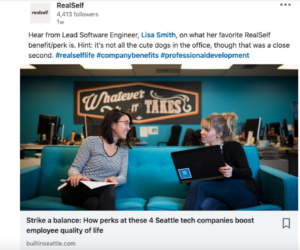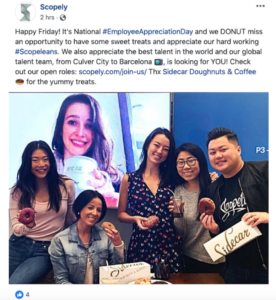Social media platforms are mostly used by companies to reach their target audience and promote their products/services. However, did you know that social media platforms are also being used by 92% of recruiters worldwide to find top talent?
Not only recruiters, but 41% of workers have also admitted that they use social media platforms to look for new job opportunities. These statistics clearly show that social media platforms are the future of recruitment and that is where you must direct your recruitment efforts in 2022.
On the flip side, if you’re not completely sure what social media recruiting means, we’ve got you covered.
What is Social Media Recruiting?
Social media recruiting (a.k.a. social recruiting) is about utilizing social media platforms to research, discover, engage and attract the ideal candidates to your company. Using social media platforms like LinkedIn, Facebook, Instagram, Twitter, etc., you can research talent on the market, network with potential candidates and share job postings.
And believe it or not, social media recruiting is one of the best ways to share the job vacancies at your company and promote your company’s culture. It also helps you establish a positive image of your company as an employer in the eyes of your ideal candidates.
In this article, we will teach you how to create a social media recruiting strategy for your company with examples and share the best practices to get started.
How to Create an Effective Social Media Recruiting Strategy?
Finding top talent in your industry isn’t always an easy feat. To overcome this challenge, you need to leverage social media platforms for finding and hiring your ideal candidates.
Here’s how to create a social media recruiting strategy for your company:
Research Your Competitors
The first step to creating an effective social media recruiting strategy is to figure out what you are actually up against.
In other words, start by finding out what social media platforms are most popular among your competitors. Then, spot the types of content your competitors are posting on each social media platform, and how well they’re performing in terms of engagement.
Create Ideal Candidate Personas
Before you can start the social media recruitment process for your company, you need to create ideal candidate personas for the vacancies you’re looking to fill.
For this, you need to create a list of personality traits, necessary qualifications, skill sets and other mandatory requirements for each vacancy at your company. And while you’re at it, make sure to analyze the areas of recruitment where your company struggles and prioritize that in your social media recruitment strategy.
Define Your Recruitment Goals
Now that you know who and where your ideal candidates are, the next step is to define your recruitment goals to benchmark your social recruiting strategy.
The easiest way to do so is by figuring out what exactly you aim to accomplish with your social media recruiting strategy which is not possible with the traditional ways of recruiting i.e. direct advertising, contact forms, cold-calling, etc.
Select the Right Social Media Platforms
Although LinkedIn and Facebook are the two biggest and most popular social media platforms used for recruiting. But you don’t need to limit yourself to those two platforms.
Depending on your ideal candidate personas and industry, you can (and should) branch out to other social media platforms to reach the top talent. Today, you can reach out to ideal candidates on Instagram, Twitter, Tiktok and many other social media platforms for recruitment purposes.
Determine Key Performance Indicators
Once you’ve decided on the social media platforms to use for recruitment, you need to determine the key performance indicators to track the success of your strategy.
The right KPIs will help to identify which social media platforms and strategies generate the highest number of ideal candidates in the shortest time.
Time, cost, referral rate, source of hire, social engagement and offer acceptance rate are some of the primary KPIs to consider for measuring the success of your social media recruitment strategy.
Optimize Content According to Each Platform’s Requirements
Every social media platform has different specific requirements such as image/video size, character count and so on.
Therefore, you shouldn’t cross-post the same content on each social media platform. Instead, you must optimize content according to each platform’s media specifications and caption length to make them polished and professional.
A/B Test Creative Assets
Up till now, you might have been A/B testing headlines or copy on your company website, but have you ever A/B tested your visual assets on social media platforms? Posting a GIF instead of a static image about job openings at your company can increase the overall engagement of your posts.
However, keep in mind to test only one option at a time. Otherwise, you’ll never know exactly which element worked best.
And while it’s true that creating and maintaining different versions of visual assets can be overwhelming. Therefore, we strongly advise you to integrate a digital asset management solution to store platform-specific versions of all your creative assets in one place.
Take Advantage of Social Media Tools
There are a plethora of social media tools like Hootsuite, Buffer, etc. to help you plan, schedule and post your content. Using these tools, you can aggregate all your social media accounts in one place, which saves you from the task of juggling back and forth.
In simple terms, social media tools help to simplify operations and save you time to post content on all social media platforms.
Social Media Recruiting Examples
Social media platforms not only make it easy to stay connected with your customers but also help you to connect with your potential candidates.
Let’s take a look at how various companies from around the world are leveraging different social media platforms for recruitment purposes.
RealSelf: LinkedIn Recruiting
LinkedIn is undoubtedly one of the best social media platforms for recruiters. It provides an unparalleled overview of candidates.
 With over 810 million professionals and being a professional social network, it’s no surprise that 87% of recruiters use LinkedIn regularly.
With over 810 million professionals and being a professional social network, it’s no surprise that 87% of recruiters use LinkedIn regularly.
RealSelf, for instance, never shies away from boasting about its awesome employee benefits in one of its LinkedIn posts.
Just like RealSelf, you can also take advantage of the LinkedIn features to showcase your company culture, perks, etc. and encourage ideal candidates for your company.
Scopely: Facebook Recruiting
Facebook isn’t a dedicated professional social network like LinkedIn, but it surely can, and is already being used for recruitment purposes.

The fact that it’s the biggest social network with just about every internet user on it (more than 2 billion users to be precise) makes it a goldmine for recruiters to find, interact with and recruit ideal candidates.
Scopely, for example, has been successfully attracting and recruiting top talent using Facebook.
Not only do Scopely share glimpses of their company culture regularly, but they also actively post about their current open positions to reach their ideal candidates all the time.
XactlyCorp: Instagram Recruiting
Though Instagram might not seem like the best place to find ideal candidates, many companies have successfully captivated their ideal candidates’ attention and encouraged them to interview.
 XactlyCorp is one of the many companies that has been leveraging Instagram to show off their company culture and employee perks in a simple yet creative format.
XactlyCorp is one of the many companies that has been leveraging Instagram to show off their company culture and employee perks in a simple yet creative format.
As you can see in their above post, they creatively added a few of their employees in one of their Instagram posts who are highlighting what they love most about working at Xactly Corp.
Social Media Recruiting Best Practices
Now that we have covered some examples of how companies are using social media for recruiting candidates, it’s time to discuss best practices for recruiting candidates on social media platforms.
Create an Editorial Calendar
Producing content every day can be time-consuming and even frustrating at times. But know that it is extremely crucial to be consistent if you want to win at the game of social media recruiting.
Moreover, you can always simplify the process by creating an editorial calendar to refer to for creating content. An editorial calendar can make it easier to plan different themes for the post and execute your strategy properly.
Get your Team on Board
Instead of assigning the task of executing your social media recruitment strategy to your HR department, it is highly recommended to involve your entire team in the social media recruitment process. Doing so will skyrocket the results.
Comment on Prospective Candidates’ Content
Since most people tend to share their thoughts on social media platforms, the odds are your prospective candidates are doing the same. And this is a perfect opportunity for your company to start a conversation with them.
So if you haven’t been commenting on your prospective candidates’ posts up till now, you need to start doing it from now onwards. This will encourage them to send a direct message, which brings us to the next point.
Send Direct Messages
Instead of waiting for your prospective candidates to reach out to you via DM, you should take charge and start the conversation from your end.
The best way to do this is by creating personalized messages for each prospective candidate and expressing your interest in hiring them. And while you’re at it, make sure to include specific information about the job vacancy so that they have all the details needed to make a well-informed decision.
Leverage the Power of Hashtags
Hashtags are the most powerful way to reach your target audience on social media platforms. However, it’s important to use relevant hashtags to ensure that your social media posts are reaching the right audience.
#hiring, #jointheteam and #jobvacancy are a few hashtag examples you can consider using in your social media recruiting posts. However, it’s not necessary to limit your posts to these hashtags. Instead, we advise you to research hashtags in your industry properly and use them accordingly.
Conclusion
With traditional recruitment methods seem to be dying a slow death, leveraging social media platforms for recruitment purposes is on the rise. It’s a modern and far more convenient way to network with top talent across the globe and connect with potential candidates that you may not have been able to reach via traditional approaches.
But don’t forget, though, that your social media recruiting strategy must be well thought out and planned. Hopefully, this article will help you with creating an effective strategy for your company.
















 With over
With over 
 XactlyCorp is one of the many companies that has been leveraging Instagram to show off their company culture and employee perks in a simple yet creative format.
XactlyCorp is one of the many companies that has been leveraging Instagram to show off their company culture and employee perks in a simple yet creative format.